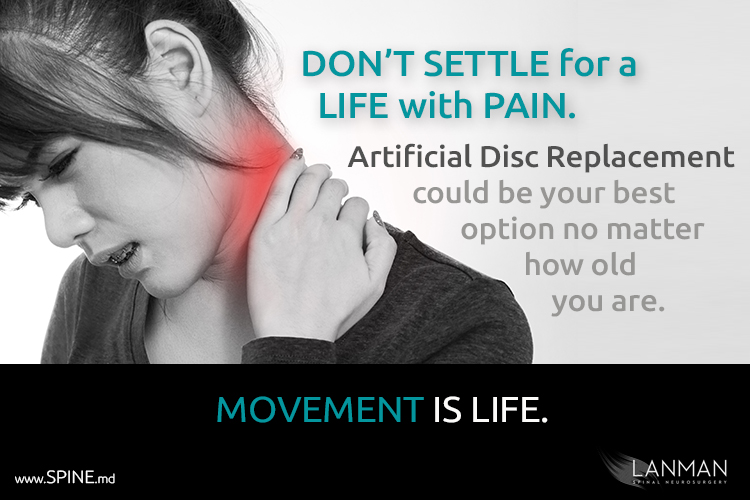You don’t have to live with chronic back and neck pain. Get diagnosed. Get treated. Start living again.
Doctors have been performing spinal fusions for more than 70 years. It is no surprise that when patients start talking about back surgery, fusion is one of the first things that comes to their mind. It’s the one procedure that evokes so much fear in patients and deep concern from friends and family members.
More than once, I’ve heard patients tell me that they’ve been warned about the dangers of spinal fusion. Their concern is for a good reason. Fusion was developed in the 1950s to solve several spinal disorders by bolting vertebrae together. This is a major surgery that can take up to seven hours to complete, and it requires up to 4 months of post-operative recovery, as long as there are no complications.
The surgeon immobilizes segments of the spine that have become unstable due to an injury, arthritis, or degenerative disc disease. As a direct result of the surgery, the patient experiences reduced flexibility from the treated segments. In some cases, depending upon the extent and location of the fusion, there is also a risk for adjacent disc failure due to stress transfer to nearby unfused levels. For that reason and other potential complications, patients require surgical revision in as little as five years later.
But we’ve come a long long way since the 1950s. Modern medicine has given us so many ways to treat chronic back and neck pain. If you’re reading this article, you may have begun to push back your fears as you learn more about what’s currently available. Here’s an important datapoint: I have two fusions myself, one in my neck and one in my lower back. Speaking as a patient, a neurosurgeon, and clinical researcher, I KNOW we can do better than fusion.
Once you meet me, one of the first things that you’ll discover about my practice in Beverly Hills, CA, is how reluctant I am to performing spinal fusion for any of my patients without looking at all of the options. You’ll also find that I’m also a strong advocate for early diagnoses. The earlier the diagnosis, the more treatment options are available.
Treatments and therapies depend upon the patient’s structural anatomy, age, bone density, and assessment of joints. But the biggest factor is time. If your symptoms have been allowed to deteriorate for too long, your options may be limited. I had a patient recently who exhibited severe cervical (neck) disc degeneration in nearly all the levels of her neck. She allowed her condition to deteriorate to such a point that fusion was the only option.
It’s rare that I see a patient who is so badly degenerated that we are so limited. Compare that with patients who quickly overcome their doubts and reluctance to get diagnosed, that their treatment may begin with non-surgical options such as physical therapy, core strengthening exercises, and supplements to help bolster the body’s ability to heal.
Sometimes the element of chance will determine what kinds of therapies I recommend. I have a recent patient with a collapsed disc in the lumbar region of the back (L5-S1). Although the case was potentially severe, the herniation missed vital nerves and is relatively pain free without surgery. She’s done so well with several non-surgical treatments that there is a likelihood that she may not need surgery for years.
Another patient in a nearly identical situation had the misfortune of having herniated disc material impinge on the sciatic nerve of the right leg. This condition is extremely painful and uncomfortable. But I was able to produce relatively quick relief with an outpatient microsurgery procedure that took about 40 minutes to perform. The patient was on his feet within a week of the procedure and was back to his usual active lifestyle within eight weeks. The same treatment can be applied to the cervical spine (neck).
For patients who need a more robust surgical treatment, there is artificial disc replacement (ADR). Compared to fusion, ADR is considered a ‘newer’ procedure. However, surgical methodology and implant technology have been in development in the U.S. for nearly twenty years. Surgeons in Europe and Japan have been performing the procedure since the 1980s.
Again, compared to fusion, the procedure presents a novel approach: replace herniated or degenerated discs with artificial disc implants. Depending upon the location of the procedure, an artificial disc replacement may take up to 2 hours, and the recovery can be as little as 3 weeks. By replacing the disc and not fusing the bones, we preserve the flexibility of the spine as we relieve the cause of pain and numbness.
In clinical studies, I’ve participated or led; artificial disc replacement surgery has produced superior outcomes in every measure tested: from neck pain, arm pain, neurologic outcomes, and reduction in surgical revision. As I mentioned, fusion may still be required, especially in cases where degeneration is very advanced, or there is joint instability. In some cases, I may combine fusion with ADR in a hybrid solution. This is what happened in my case. I have six artificial discs in addition to my two fusions. My nerve pain is gone, and joints are stabilized, but I was also able to maintain as much flexibility and range of motion as possible.
If you learn one thing here, please recognize that chronic back, and neck pain is not the end of your life, and surgery is not the end of the world. Fear is your only impediment in finding out what procedures are best for you to live a pain-free, higher quality of life.
When we are fearlessly proactive about our spine health, it is far easier to be Greater than Better.







